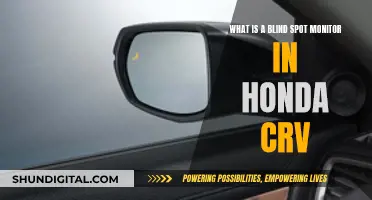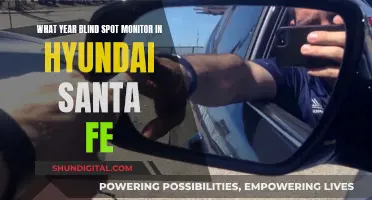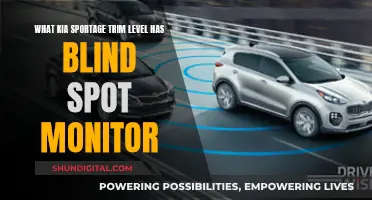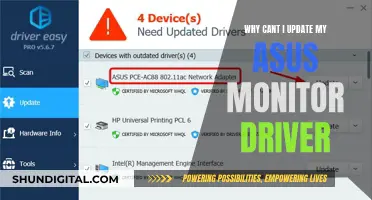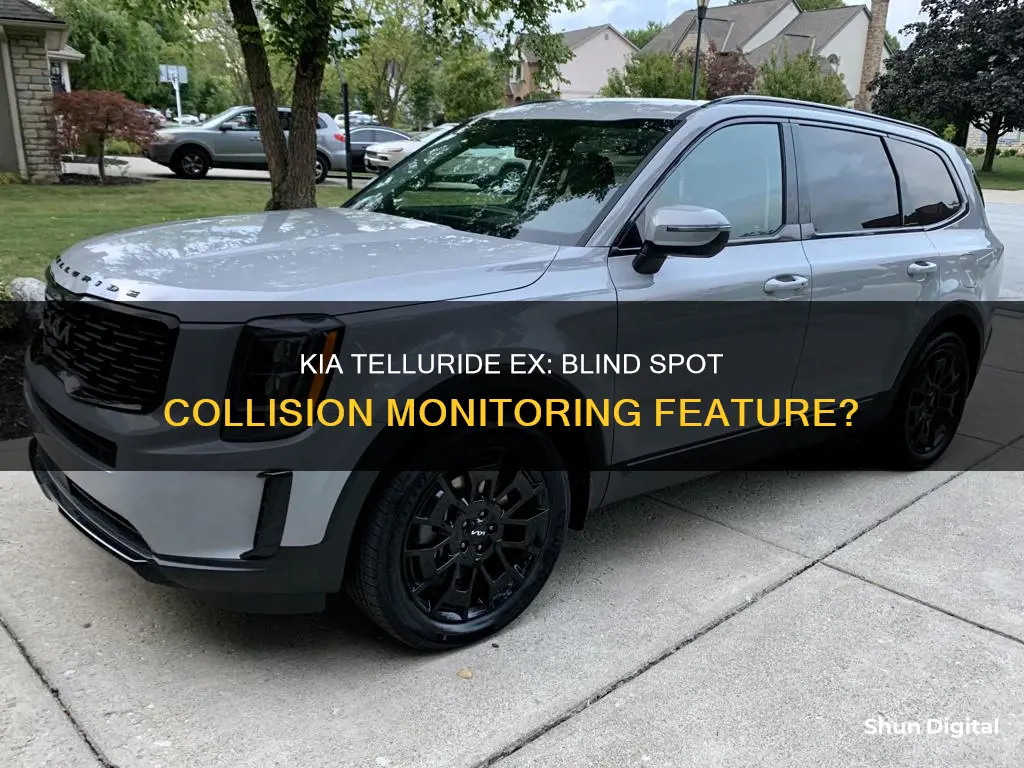
Kia's blind-spot monitoring and crash avoidance system won the 2020 Autoblog Technology of the Year Award. The system includes a blind-spot warning light in the side mirror, a head-up display, steering wheel vibration, and a Blind Spot View Monitor that displays a live feed of the blind spot in the gauge cluster. The Blind Spot Collision Avoidance (BCA) system also applies the brakes to prevent a collision. While the BCA system has some limitations, such as not working optimally in inclement weather or when towing a trailer, it is a valuable safety feature for drivers. The Kia Telluride EX, a popular SUV model, includes blind-spot monitoring as a standard feature. However, it is worth noting that some users have reported issues with the blind-spot monitoring system in the EX model, and it may not be as advanced as the systems in higher-end models. Overall, Kia's blind-spot monitoring and collision avoidance technology offers drivers an innovative and comprehensive safety system that enhances their driving experience.
What You'll Learn

Kia Telluride EX's blind-spot monitoring system
The Kia Telluride EX does have a blind-spot monitoring system, which is part of Kia's Blind-Spot Collision-Avoidance Assist (BCA) system. This system is designed to help keep drivers safe by warning them of vehicles in their blind spot and even taking action to avoid a collision if necessary.
The BCA system uses a combination of visual, audible, and haptic warnings to alert the driver of potential hazards. When a vehicle enters the Telluride's blind spot, a warning light illuminates on the side mirror, and if the driver activates the turn signal, an audible chime sounds and the steering wheel begins to vibrate gently. This provides a clear and effective warning without being overly distracting.
In addition to these warnings, the Telluride also features a Blind Spot View Monitor. This system uses cameras to display a live feed of the blind spot on the left or right side of the vehicle in the central digital portion of the gauge cluster when the turn signal is activated. This allows the driver to see their blind spot without having to turn their head, providing an extra layer of safety and convenience.
The BCA system also includes collision avoidance capabilities. If the system detects an approaching vehicle in the blind spot or too close to the Telluride, it can apply the brakes on the opposite side to gently pull the vehicle back into its lane and avoid a collision. This feature is designed to intervene only when necessary and provides a helpful safeguard to prevent accidents.
While the BCA system is generally reliable, it does have some limitations. For example, it may not function properly in certain weather conditions, such as heavy snow or rain, or when the sensors are blocked by foreign material like snow, rain, or dirt. It may also not work as effectively at lower speeds or on curved, inclined, or merging roads. Additionally, the system may not detect certain types of vehicles or obstacles, such as motorcycles, bicycles, or low-height sports cars.
Overall, the Kia Telluride EX's blind-spot monitoring system, as part of the BCA suite, offers a comprehensive set of features that enhance driver safety and awareness. While not perfect, it provides valuable assistance and peace of mind, especially when navigating busy city streets or crowded highways.
Best ASUS Monitors for 2K Resolution: Top Picks
You may want to see also

Collision avoidance system
The Kia Telluride EX comes with a comprehensive collision avoidance system. The system is designed to provide the driver with multiple warnings if there is a vehicle in their blind spot. Firstly, a warning light will appear in the side mirror. Secondly, when the head-up display is enabled, a second warning light will be beamed onto the windshield. This is particularly useful as it is in the driver's line of sight, meaning they don't have to turn their head to check their blind spot.
If the driver then activates their turn signal and there is a vehicle in their blind spot, the steering wheel will vibrate and a warning chime will sound. This is intended to grab the driver's attention without being violent or distracting. The system also includes a Blind Spot View Monitor, which uses a system of cameras to display a live feed of the left or right blind spot in the central digital portion of the gauge cluster when the turn signal is activated. This allows the driver to see their blind spot without having to turn their head.
The final stage of the system is the Blind-Spot Collision Avoidance (BCA) software. This uses radar sensors to detect the presence of another vehicle beside or next to the Telluride, and a front-facing camera to keep track of the lane markings. If the system detects an approaching vehicle next to or too close behind the Telluride, it will apply the brakes on the opposite side of the car to pull it back into its lane and prevent a collision.
There are some limitations to the system, which are detailed in the car's owner's manual. For example, it may not work in inclement weather, or when driving on a curved or inclined road. It is also less likely to work when the other vehicle is travelling at a high speed or when the Telluride is passing another vehicle.
Understanding Monitor Sizes: Diagonal Measurement Method Explained
You may want to see also

Limitations of the system
The Blind-Spot Collision Avoidance (BCA) system in the Kia Telluride has several limitations that can affect its functionality. Here are some detailed points to note about the limitations of the system:
- Inclement Weather: The BCA system may not function optimally during heavy snow or heavy rain. It is important to keep the rear corner radar clear of any snow, rain, or dirt buildup.
- Temperature Extremes: Extreme temperatures, whether high or low, can impact the performance of the rear corner radar.
- Obstructions: The system may not work properly if the rear corner radar is obstructed by vehicles, pillars, walls, or other structures.
- Highway Ramps and Tollgates: The BCA system may not operate effectively on highway ramps and tollgates.
- Road Construction: The presence of metallic components in the road pavement or peripheral ground, possibly due to subway construction, can interfere with the system.
- Fixed Objects: The presence of fixed objects near the vehicle, such as sound barriers, guardrails, central dividers, street lamps, tunnels, or walls, can affect the system's performance.
- Narrow Roads: Overgrown trees or grass on narrow roads can obstruct the sensors and impact the system.
- Large Open Areas: The system may not work as expected in large areas with few vehicles or structures, such as deserts, meadows, or suburbs.
- Wet Road Surfaces: Driving on wet roads or through puddles can affect the system's functionality.
- Proximity to Other Vehicles: The BCA system may not operate normally if other vehicles drive very close behind or pass by in close proximity. Additionally, if a vehicle in the next lane moves away quickly, the system may not detect it.
- Lane Changes and Acceleration: The system may not function properly during lane changes or when your vehicle accelerates from a stationary position alongside another vehicle.
- Trailers or Carriers: Installing a trailer or carrier around the rear corner radar can interfere with the system's performance.
- Bumper Obstructions: Objects attached to or covering the bumper, such as bumper stickers, bike racks, or other equipment, can impact the system.
- Damage to Bumper or Radar: Any impact or damage to the bumper or radar being out of position can affect the system's functionality.
- Vehicle Height: If your vehicle's height is altered due to heavy loads, abnormal tire pressure, or other factors, the system may not operate normally.
- Motorcycles, Bicycles, and Moving Obstacles: The system may not always detect motorcycles, bicycles, or moving obstacles like pedestrians, animals, shopping carts, or baby strollers.
- Large Vehicles: The BCA system may not always detect large vehicles such as buses or trucks.
- Curved, Merging, or Dividing Roads: Blind-Spot Collision Avoidance may not operate properly on curved roads, roads with different lane heights, or where the road is merging or dividing. It may fail to detect vehicles in the next lane or incorrectly detect the ground or structures.
- Inclined Roads: Driving on sloped roads can affect the system's performance, and it may not detect vehicles in the next lane accurately.
- Electromagnetic Interference: Strong electromagnetic waves can interfere with the proper functioning of the BCA system.
- Initialization: The system may not operate for approximately 15 seconds after the vehicle is started or when the front view camera or rear corner radars are initialized.
Monitors for 144Hz Gaming: Size and Feature Considerations
You may want to see also

Blind-Spot Collision-Avoidance Assist settings
The Blind-Spot Collision-Avoidance Assist (BCA) system in the Kia Telluride has three settings: Active Assistance, Warning Only, and Off.
When set to Active Assistance, the BCA system will warn the driver of a potential collision with a warning message, an audible warning, steering wheel vibration, and, depending on the risk level, braking assistance. The Warning Only setting is similar but does not include braking assistance.
If the BCA system is turned off, the driver will be notified with a message on the cluster that the Blind-Spot Safety System is off. The driver should always be aware of their surroundings and drive safely.
The Warning Timing setting can be changed from Normal to Late. Normal is for typical driving conditions, and Late is for when Normal feels too sensitive, or when traffic is light or driving at low speeds.
The Warning Volume can be adjusted to High, Medium, Low, or Off. If Driving Safety Priority is selected, the audio volume will decrease temporarily to warn the driver with an audible warning for safe driving.
It is important to note that the BCA system may not operate normally under certain circumstances, such as inclement weather, radar obstruction, driving on curved or inclined roads, or when interfered with by strong electromagnetic waves.
Connecting a MacBook to an iMac and External Monitor
You may want to see also

Blind-Spot Collision-Avoidance Assist malfunction and limitations
The Blind-Spot Collision-Avoidance Assist (BCA) system in Kia vehicles is designed to help detect and monitor approaching vehicles in the driver's blind spot area, warning the driver of a potential collision through a warning message, an audible alert, steering wheel vibration, or braking assistance, depending on the risk level. However, this system has certain limitations and can malfunction under specific circumstances.
One limitation of the BCA system is its detecting range, which varies with the speed of the vehicle. At high speeds, the function may not provide a warning when passing by vehicles in the blind spot area. Additionally, the system's warning timing can differ based on the speed of the approaching vehicle.
The BCA system relies on sensors in the rear bumper to function effectively. Any impact or damage to the rear corner radar or its surrounding area can impair the system's performance. This includes instances of applying paint to or modifying the genuine Kia rear bumper without using equivalent standard parts. Obstructing the rear corner radar with objects like license plate frames, bumper stickers, or guards can also hinder the system's operation.
Furthermore, attaching a trailer, carrier, or other equipment to the vehicle may adversely affect the performance of the rear corner radar or render the function inoperative. The BCA system may also have limitations in certain driving conditions, such as sharp curves or driving on slopes, as indicated by user experiences.
In some cases, the BCA system may malfunction or fail to operate as intended. Users have reported instances where the system did not provide warnings at specific speed ranges, such as below 20 mph or above 40 mph. However, it is important to note that these speed ranges may vary based on the type of object detected and the warning type.
To address BCA system malfunctions or limitations, it is recommended to refer to the vehicle's manual, adjust settings, and consult authorized Kia dealers or service partners for professional inspections and advice.
LCD TVs and Monitors: What's the Difference?
You may want to see also
Frequently asked questions
No, blind-spot collision monitoring is not available on the EX model.
Blind-Spot Collision-Avoidance Assist (BCA) is a system that warns the driver of potential collisions with an audio warning, a warning message, steering wheel vibration, and braking assist depending on the collision risk levels.
The system uses radar sensors and cameras to detect the presence of other vehicles, obstacles, or people in the vehicle's blind spot. It can then warn the driver or take action to avoid a collision.
Blind-Spot Collision-Avoidance Assist may not function properly in certain circumstances, such as inclement weather, driving on curved or inclined roads, or when the sensors are blocked by foreign material or a trailer/carrier.
No, it cannot be added as it requires specific cameras and mirrors that are not included on the EX model.


